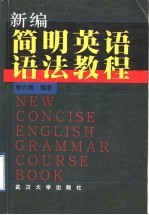图书介绍
新编简明英语语法教程 修订版PDF|Epub|txt|kindle电子书版本网盘下载

- 林六辰编著 著
- 出版社: 武汉:武汉大学出版社
- ISBN:7307032112
- 出版时间:1999
- 标注页数:418页
- 文件大小:8MB
- 文件页数:434页
- 主题词:英语(学科: 语法) 英语 语法
PDF下载
下载说明
新编简明英语语法教程 修订版PDF格式电子书版下载
下载的文件为RAR压缩包。需要使用解压软件进行解压得到PDF格式图书。建议使用BT下载工具Free Download Manager进行下载,简称FDM(免费,没有广告,支持多平台)。本站资源全部打包为BT种子。所以需要使用专业的BT下载软件进行下载。如BitComet qBittorrent uTorrent等BT下载工具。迅雷目前由于本站不是热门资源。不推荐使用!后期资源热门了。安装了迅雷也可以迅雷进行下载!
(文件页数 要大于 标注页数,上中下等多册电子书除外)
注意:本站所有压缩包均有解压码: 点击下载压缩包解压工具
图书目录
导论(Introduction)1
0.1什么是语法?(Whatisgrammar?)1
0.2英语语法的结构层次(ThehierarchyofEnglishgrammar)2
第一讲 句子结构(Sentencestructure)7
1.1主语和谓语(Subject predicate)7
1.2基本句型和词类(Basicclausetypes partsofspeech)9
1.3基本句型的转换与扩展(Transformation expan-sionofbasicclausetypes)10
第二讲 名词(Nouns)114
2.1名词的种类(Classificationofnouns)14
2.2名词的数(Number)15
第三讲 名词(Nouns)222
3.1名词的性(Gender)22
3.2名词的格(Case)23
第四讲 冠词(Articles)29
4.1冠词的语义及用法(Systemsofarticleusage)29
4.2定冠词的类指惯用法(Idiomaticusageofdefinitearticlewithgenericreference)30
4.3普通名词的零冠词用法(Commonnounswithzeroarticle)32
第五讲 代词(Pronouns)139
5.1代词分类(Subclassesofpronouns)39
5.2中心代词(Centralpronouns)40
5.3指示代词(Demonstrativepronouns)42
第六讲 代词(Pronouns)247
6.1整体代词(Universalpronouns)47
6.2部分代词(Partitivepronouns)49
6.3数量代词(Quantifyingpronouns)51
第七讲 限定词(Determiners)58
7.1所指限定词和数量限定词(Identifiers quantifiers)58
7.2限定词与名词的搭配(Cooccurrenceofdeterminerswithnouns)59
第八讲 动词(Verbs)67
8.1动词的分类(Typesofverb)67
8.2动词的限定形式和非限定形式(Finiteandnon-finiteverbphrase)68
8.3规则动词与不规则动词(Regularverb irregularverb)69
8.4动词的静态意义和动态意义(Stativeverb dy-namicverb)71
第九讲 动词的时(Tense)77
9.1一般现在时(Thesimplepresenttense)77
9.2一般过去时(Thesimplepasttense)79
第十讲 动词的体(Aspect)185
10.1动词的体(Aspect)85
10.2现在完成体(Thepresentperfective)86
10.3过去完成体(Thepastperfective)87
第十一讲 动词的体(Aspect)293
11.1进行体(Theprogressiveaspect)93
11.2完成进行体(Theperfectprogressive)94
第十二讲 将来表达法(Thefuture)101
12.1“Will/shall+动词”(Will/shall+V.)101
12.2“Begoingto+动词”(Begoingtodosth.)102
12.3现在进行体(Thepresentprogressive)102
12.4一般现在时(Thesimplepresenttense)103
12.5“Will/shall+进行体”(Will/shall+progressive)103
12.6“Be+不定式”(Betodosth.)104
12.7“Beabout+不定式”(Beabouttodosth.)104
13.2被动态的应用(Usesofthepassive)111
13.1主动态与被动态之间的对应关系(Theactive-passivecorrespondence)111
第十三讲 被动态(Passivevoice)111
13.3Get-被动态(Get-passive)113
13.4主动态与被动态转换的一些限制(Voiceconstraints)114
第十四讲 虚拟式(Subjunctivemood)121
14.1Be-型虚拟式(Be-subjunctive)121
14.2Were-型虚拟式(Were-subjunctive)123
14.3虚拟式的否定构成(Thenegativeformofsub-junctivemood)123
第十五讲 情态动词(Modalauxiliaries)127
15.1情态动词(Can,could,may,might)127
15.2情态动词(Shall,will,would)128
15.3情态动词(Should,oughtto,must,haveto)130
15.4情态动词与体(Themodals aspect)131
15.5情态动词(Need,dare)132
15.6情态动词(Usedto)133
15.7情态习语(Modalidioms)134
第十六讲 不定式(Infinitive)140
16.1否定不定式(Negativeinfinitive)140
16.2分裂不定式(Splitinfinitive)140
16.3省略不定式(Ellipticalinfinitive)141
16.4不定式与形容词搭配(Usedasadjectivecomple-ment)143
16.5不定式与名词搭配(Usedaspost-modifierofnoun)144
16.6不定式与动词搭配(Usedasobjectorobjectcomplement)145
第十七讲 -ing分词(-ingparticiple)151
17.1-ing分词的句法作用及否定构成(Thesyntacticfunctionof-ingparticipleanditsnegativeform)151
17.2-ing分词前置修饰名词时与名词的句法关系(Thesyntacticrelationbetweenthe-ingparticipleandthenounitpre-modifies)152
17.3-ing分词与动词的搭配(Usedastheobjectofverb)152
第十八讲 -ed分词(-edparticiple)159
18.1-ed分词的构成及意义(Theformof-edpartici-pleanditsmeaning)159
18.2-ed分词的句法作用(Thesyntacticfunctionof-edparticiple)159
第十九讲 形容词(Adjectives)167
19.1形容词的分类(Theclassificationofadjectives)167
19.3形容词的句法作用(Syntacticfunctionsofadjectives)169
19.2形容词与分词(Adjectives participles)169
第二十讲 副词(Adverbs)177
20.1副词的构成及意义(Theformationofadverbsandtheirmeanings)177
20.2副词的句法作用(Syntacticfunctionsofadverbs)178
第二十一讲 比较等级和比较结构(Comparison compara-tiveconstruction)185
21.1形容词和副词的比较等级(Comparisonofadjec-tives adverbs)185
21.2比较结构(Comparativeconstructions)186
21.3其他比较结构及对比(Othercomparativeconstruc-tionsandtheircontrast)191
第二十二讲 介词词组(Prepositionalphrases)196
22.1简单介词与复杂介词(Simple complexprepositions)196
22.2介词与形容词、动词、名词的搭配(Collocationofprepositionswithadjectives,verbs nouns)197
22.3介词词组的句法作用(Syntacticfunctionsofprepositionalphrases)199
第二十三讲 主谓一致(Subject-predicateconcord)206
23.1名词词组作主语(NounPhrasesassubject)206
23.2含有并列结构的主语(Subjectwithcoordination)209
23.3分句作主语(Clausesassubject)211
23.4不符合意义一致原则的特殊情况(Fewexceptions)212
第二十四讲 简单句(Simplesentence)1217
24.1陈述句(Statements)217
24.2疑问句(Questions)219
25.1祈使句(Commands)228
第二十五讲 简单句(Simplesentence)2228
25.2感叹句(Exclamations)230
25.3惯用语(Formulae)231
第二十六讲 并列结构(Coordinateconstruction)234
26.1并列结构的形式(Coordinationatdifferentlevels)234
26.2并列连词的意义及用法(Themeaningsofcoor-dinatorsandtheirusage)235
26.3并列结构中的标点符号(Punctuationwithincoordinatedstructures)237
第二十七讲 从属结构(Subordinateconstruction)243
27.1从属分句的构成形式(Formsofthesubordinateclause)244
27.2从属连词(Subordinators)244
27.3从属分句的句法作用(Syntacticfunctionsofthesubordinateclause)246
第二十八讲 名词性分句(Nominalclauses)250
28.1名词性that-分句(Nominalthat-clause)250
28.2名词性疑问分句(Nominalinterrogativeclauses)251
28.3名词性关系分句(Nominalrelativeclause)252
第二十九讲 关系分句(Relativeclauses)261
29.1限制性关系分句(Restrictiverelativeclause)261
29.2非限制性关系分句(Non-restrictiverelativeclause)263
29.3句际关系分句(Sententialrelativeclause)263
29.4双重关系分句和嵌入式关系分句(Doublerelativeclause embeddedrelativeclause)264
29.5关系分句与同位语分句(Relativeclausevs.appositiveclause)265
30.1时间状语分句(Adverbialclauseoftime)272
第三十讲 状语分句(Adverbialclauses)272
30.3方式状语分句(Adverbialclauseofmanner)273
30.2地点状语分句(Adverbialclauseofplace)273
30.4原因状语分句(Adverbialclauseofcause)274
30.5目的状语分句(Adverbialclauseofpurpose)274
30.6结果状语分句(Adverbialclauseofresult)275
30.7让步状语分句(Adverbialclauseofconcession)275
第三十一讲 条件句(Conditionalsentence)282
31.1真实条件句(Realconditional)282
31.2虚拟条件句(Unrealconditional)284
32.1不定式分句(Theinfinitiveclause)290
第三十二讲 非限定分句和无动词分句(Nonfiniteclauses verblessclause)290
32.2-ing分词分句(The-ingparticipleclause)292
32.3-ed分词分句(The-edparticipleclause)295
32.4无动词分句(Theverblessclause)297
第三十三讲 直接引语和间接引语(Direct indirectspeech)303
33.1陈述句的间接引语(Indirectstatements)303
33.2疑问句、感叹句和祈使句的间接引语(Indirectquestions,commands exclamations)305
33.3间接引语中的情态动词(Themodalauxiliaries indirectspeech)306
34.1英语句子的特点(FeaturesofEnglishsentence)312
34.2There-句型(Existentialsentence)312
第三十四讲 There-句型(Existentialsentence)312
34.3形式主语there(Existentialthereassubject)314
34.4There-句中的关系分句(Relativeclauseinexis-tentialsentence)314
34.5非be动词there-句型(Existentialsentencewithverbsotherthanbe)315
第三十五讲 It-句型(It-patterns)318
35.1虚义it(Propit)318
35.2先行it(Anticipatoryit)319
35.3裂式强调it(Itasintroductorywordofcleftsentence)319
35.4拟似分裂句(Pseudo-cleftsentence)321
36.1前置(Fronting)325
第三十六讲 前置与倒装(Fronting inversion)325
36.2倒装(Inversion)326
第三十七讲 替代与省略(Substitution ellipsis)333
37.1替代(Substitution)333
37.2省略(Ellipsis)336
第三十八讲 从句到篇(Fromsentencetotext)343
38.1句子和语篇(Sentence text)343
38.2语篇纽带(Textualconnectors)344
练习参考答案352
语法术语缩略语及符号说明416
参考书目418